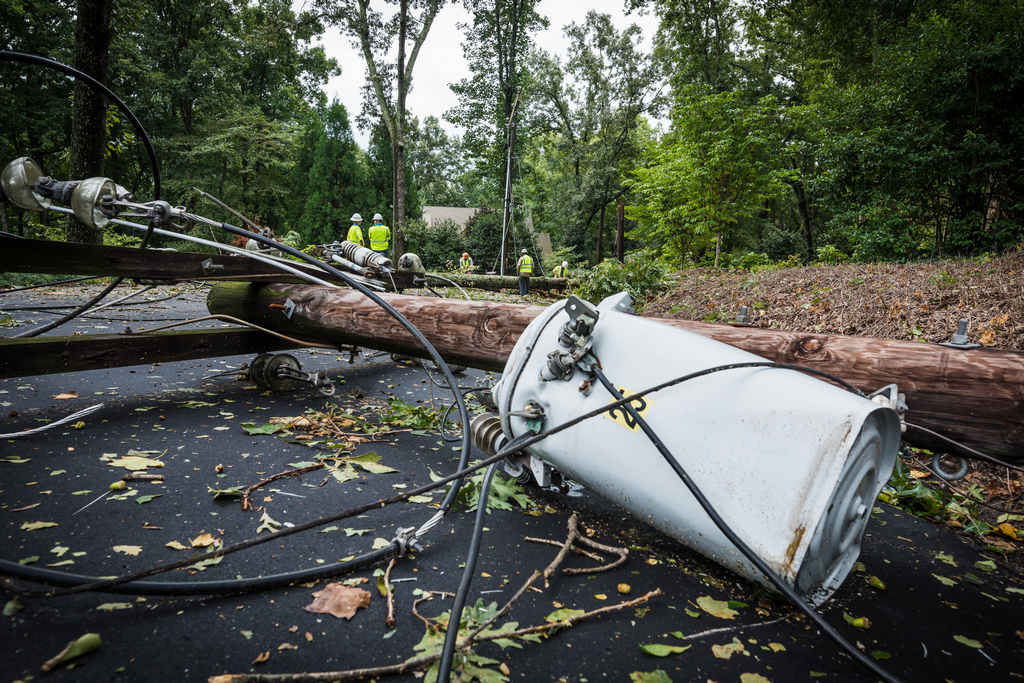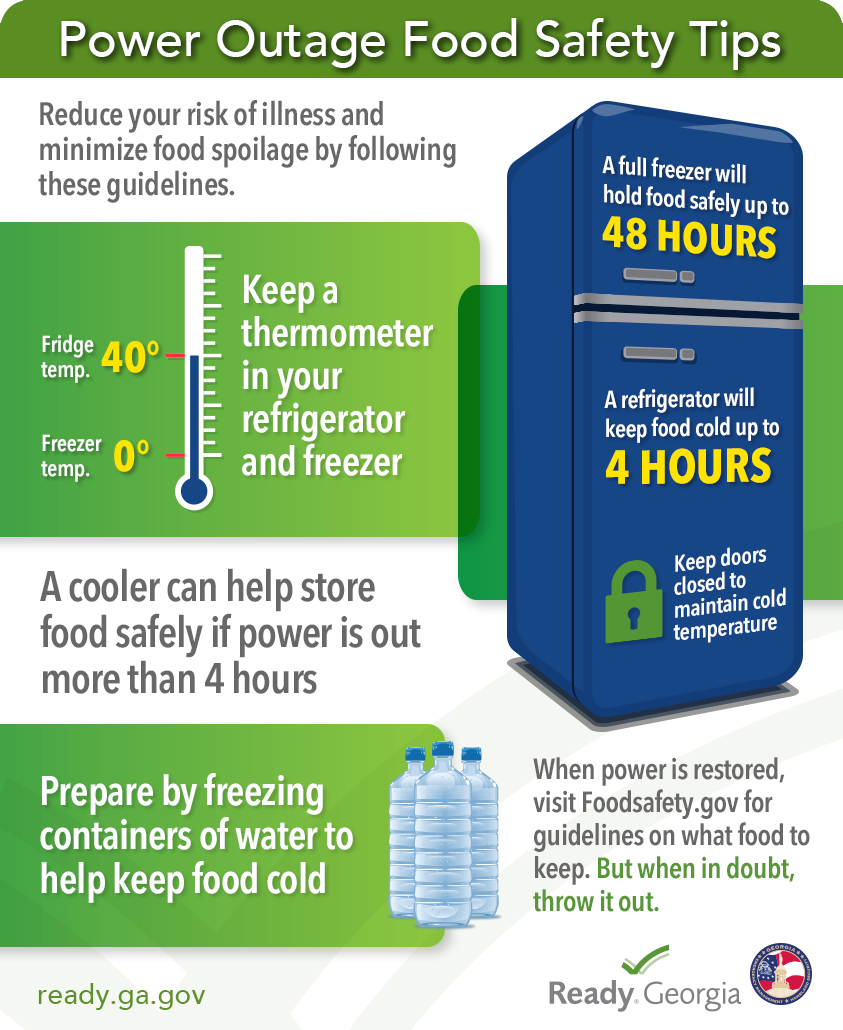When your home loses power, due to a severe or extreme weather event, deal first with the biggest safety issues: bringing light to the dark, staying warm and dry, and providing food to yourself and your family.
Prolonged power outages can be dangerous when dealing with food safety. Keeping perishable foods at a safe temperature is a must. When food temperatures exceed 40°F, bacteria start to grow, and foods begin to become unsafe.
 Image Source: Shutterstock
Image Source: Shutterstock When the power and your refrigerator goes out, special food safety measures must be taken. Knowing how to determine if food is safe and how to keep food safe will help minimize the potential loss of food and reduce the risk of foodborne illness.
- Learn about foodborne pathogens, cross contamination, cold and hot food safety, and best practices to prevent foodborne illness.
- Food Manager ANSI Certification: $99.00 - Valid in all States
- Food Handler Training: Only $7.00!
- 10% OFF: Enter Promo Code "train10off" at Checkout
Before a Power Outage
- Purchase one or more coolers. Purchase one cooler for drinks and snacks and another for perishable food. The drink cooler will be opened and closed a lot, which lets hot air in and causes the ice to melt faster.
- Gel Ice Packs. A cold cooler for perishable food is essential. If you plane to use a cooler, pack them with several inches of ice or frozen gel-packs. Store food in watertight containers to prevent contact with melting ice water.
- Stock shelf-stable foods. Shelf-stable food is food of a type that can be safely stored at room temperature in a sealed container. Shelf-stable foods, such as canned goods and powdered or boxed milk. These can be eaten cold or heated on the grill.
- Purchase a food thermometer. A food thermometer should be a necessity in your kitchen anyway. With these thermometers you can quickly check the internal temperatures of food safely.
During Power Outage
- Do not open the refrigerator or freezer. An unopened refrigerator will keep foods cold enough for a couple of hours at least. A freezer that is half full will hold for up to 24 hours and a full freezer for 48 hours.
- Outages that last for hours. If it looks like the power outage will be for more than 2-4 hours, pack the important items in your refrigerator, such as milk, dairy products, meats, fish, poultry, eggs, and left-overs into your cooler surrounded by ice. Keep temperature at or below 40 degrees. Throw away any items that have been exposed to temperatures greater than 40 degrees for more than two hours.
- Prolonged Outages. If it looks like the power outage will be prolonged beyond a day or so, prepare another cooler with ice for the items in your freezer.

When Power Returns – Frozen Foods
When the freezer is operating again, use these guidelines to decide what to do with foods that were stored in the freezer:
- If ice crystals are still visible and/or the food feels as cold as if refrigerated (40° F or below), it is safe to refreeze.
- Raw meats and poultry, cheese, juices, breads and pastries can be refrozen without losing a lot of quality.
- Prepared foods, fish, vegetables and fruits can be refrozen safely, but quality may suffer. Mark these to be used as soon as possible. Remember that seafood will be among the first to thaw and will need attention first. Also, ground meat is likely to spoil before other meats.
- If the food thawed and has not been above 40o F for more than 2 hours, cook and serve or refreeze.
- If the food thawed or was held above 40o F for more than 2 hours, generally it should be discarded because bacteria may multiply to unsafe levels under these conditions. The only foods that can be refrozen under these conditions are well-wrapped hard cheeses, butter and margarine, breads and pastries without custard fillings, fruits and fruit juices that look and smell acceptable.
- Vegetables held above 40o F for less than 6 hours may be refrozen with quality loss.
- Pecans and other nuts may be refrozen safely but may suffer quality loss.
When Power Returns – Refrigerated Foods
When the refrigerator is operating again, use these guidelines to decide what to do with foods that were stored in the refrigerator:
- Throw away leftovers and perishable foods that have been held above 40oF for more than 2 hours, including meats, poultry, fish, seafood, lunch meats, hot dogs, milk, cream, sour cream, yogurt, cream cheese, cottage cheese, soft cheeses, soy milk and eggs.
- Hard cheese and processed cheese will be okay.
- Well-wrapped butter and margarine can usually be kept as long as they do not melt; discard if rancid odors develop.
- Condiments such as ketchup, mustard, mayonnaise, pickles, relishes, piquant sauce, oil and vinegar-based salad dressings, Worcestershire sauce and steak sauces should be fine. The acid in them is a natural preservative. Jams, jellies, preserves and syrups are all right, too, because sugar is a preservative. Check for mold growth. Discard opened mayonnaise, horseradish and tartar sauce if held above 50o F for more than 8 hours.
- Discard milk, cream, sour cream, yogurt, cream cheese, soy milk and eggs if held above 40o F for more than 2 hours.
- Whole fresh fruit, dried fruits, opened fruit juices and fresh vegetables are safe as long as they’re still firm and there’s no evidence of mold, a yeasty smell or sliminess, but discard cut fruits; precut, prewashed packaged greens and opened vegetable juices if held above 40o F for more than 2 hours.
- Nuts and peanut butter also are safe.
Summary
Prolonged power outages can be dangerous when dealing with food safety. Keeping perishable foods at a safe temperature is a must. When food temperatures exceed 40°F, bacteria start to grow, and foods begin to become unsafe.
When the power and your refrigerator goes out, special food safety measures must be taken. Knowing how to determine if food is safe and how to keep food safe will help minimize the potential loss of food and reduce the risk of foodborne illness.
